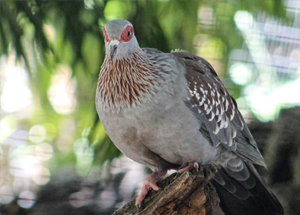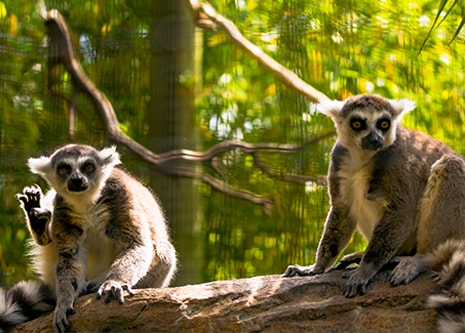
- VisitSupport Happy HollowDONATE TODAYExploreSupport Happy HollowDONATE TODAYLearnSupport Happy HollowDONATE TODAYSupport
-
Today's Hours: 10:00 am to 4:00 pm
Zoo in the HollowSpeckled pigeon

Scientific name: Columba guinea
Family:Columbidae
Order:Columbiforms
Class:Aves
Range: Sub-Saharan Africa
Habitat: Grassland, urban
Lifespan: Unknown; other Columba species 6 to 10 years in the wild and over 30 years in captivityWhat do they look like?
Speckled pigeons are larger than their rock dove cousins, which are more commonly known as just “pigeons” in the United States. Speckled pigeons can reach up to 16 inches long. Males and females look the same, although males may be more heavily built. Speckled pigeons have grey bellies, tails, and heads. The back and top of the wings are maroon. The lower portion of their wings are adorned with white spots. The neck is maroon or brown in color with white streaks, adding to a fluffed appearance. There are no feathers around their golden-colored eyes, revealing the red skin below. Their feet are pink or red, with three toes facing forward and one facing backwards.How do they behave?
This species is found in many areas of Africa south of the Sahara Desert. They are found in grasslands, farmlands, and around human establishments. They are quick fliers but are also comfortable walking or running on the ground. They are usually seen in pairs but may congregate into large flocks. They make a loud, forceful cooing noise.What do they eat?
Speckled pigeons primarily eat seeds, grains, and peanut crops. Like all members of the family Columbidae, speckled pigeons can suck water up through their beaks like a straw, whereas most birds have to toss their head back to drink. At Happy Hollow, they have a specialized diet made of pellets, fruits, and vegetables.How are they born?
Breeding may occur year-round, but is most common during the end of the dry season. A male performs a dance of sorts by posturing, lowering his head, twitching his wings, and vocalizing. Pairs build a large stick nest in a tree, building or cliff. The female usually lays two small, white eggs which will hatch approximately two weeks later. When the eggs hatch, the chicks emerge covered in yellow down feathers. Both parents feed the chicks with crop milk (a secretion from the lining of the digestive tract). They will fledge 20-25 days after hatching. As they grow, their feathers will change from yellow to brown. Eventually their adult plumage will grow in when they reach maturity.Conservation
The International Union for Conservation of Nature lists the speckled pigeon’s conservation status as Least Concern. The speckled pigeon is quite common throughout its range, and its population is very stable. However, these birds do have a conservation connection with other members of their family, known by the common name as doves. Sometimes doves, and pigeons, are purchased from pet stores and released at special events. This can be harmful to both the birds and the local wildlife because the doves or pigeons may not know how to survive on their own, and could end up taking valuable resources from native wildlife in the area. If you would like to help both doves and pigeons, educate your friends about them and make sure not to release them at your special events.
Zoo on the Hill
Located across from the Keep-Around Carousel is the Zoo on the Hill. Learn about wildlife up close during daily meet-and-greets, leap like a lemur on the playground, brush and feed the goats,, or take a peek inside Doc’s Critter Care building and the Ranch House. Double-H Ranch features a combination of animal exhibits, including giant anteaters and red ruffed lemurs, as well chickens and domesticated animals that are docile enough to touch.
See Animals
Education Ambassadors
From camps and classes to scout badges and sleepovers, Happy Hollow education programs have something for everyone! The zoo education program offers a broad range of hands-on, engaging programs and public presentations featuring education ambassador animals. These encounters are designed to connect you to wildlife and the conservation of their habitats around the world.
See AnimalsVisit Us Today
Plan an unforgettable experience at San Jose’s family-friendly park and zoo.
Learn More